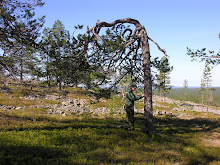Last week I got my first touch to field work in a completely new environment - eucalyptus plantings and South Australian native vegetation remnants - during a day trip to a test site where several hyperspectral (and LiDAR) remote sensing projects are carried out by my new colleagues at the University of Adelaide.
Before the trip, I had a glimpse at some hyperspectral images from the test site and browsed through some forest inventory data. However, I still couldn't imagine what the area would look like in real life.
Before the trip, I had a glimpse at some hyperspectral images from the test site and browsed through some forest inventory data. However, I still couldn't imagine what the area would look like in real life.
Very different from what I was accustomed to, that's for sure. There were about 30 different tree species in a small area (I didn't know any of them), mallees, the ground was bare (with patches of green and yellow grasses). One thing is in common with coniferous canopies: the grouped structure of many of the eucalyptus crowns. I guess it's a good starting point to find some common factors in a new environment - psychologically, at least!
So, why the field trip? During the next few months, I will be collaborating with the local researchers and testing some of the approaches (such as the 'p-theory' for modeling canopy reflectance) that I have been working with in the boreal forests. This time only the environment will be very different -- hot, dry and full of eucalyptuses. Looking forward to the challenge and change!


No comments:
Post a Comment